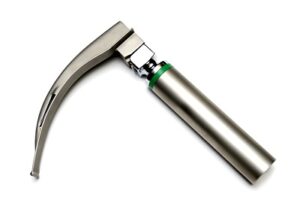 A laryngoscope is a medical device used to visualize the vocal cords and the inside of the larynx (voice box) during intubation or other procedures that require access to the airway. It consists of a handle and a blade that holds a light source to illuminate the area being examined. Laryngoscopes are an essential tool in anesthesia and emergency medicine for establishing an airway and ensuring proper placement of an endotracheal tube.
A laryngoscope is a medical device used to visualize the vocal cords and the inside of the larynx (voice box) during intubation or other procedures that require access to the airway. It consists of a handle and a blade that holds a light source to illuminate the area being examined. Laryngoscopes are an essential tool in anesthesia and emergency medicine for establishing an airway and ensuring proper placement of an endotracheal tube.Parts of a Laryngoscope:
- Handle: The handle is the part held by the healthcare provider. It typically houses the batteries that power the light source and may have an on/off switch. Some advanced handles also include features like adjustable light intensity.
- Blade: The blade is the curved or straight attachment that holds the light source. The shape of the blade varies depending on the type of laryngoscope and its intended use. It is inserted into the patient's mouth to gently lift the tongue and soft tissues, allowing a clear view of the vocal cords.
- Light Source: The blade contains a light source, usually an LED, that provides illumination for visualization of the airway structures.
Types of Laryngoscopes:
There are several types of laryngoscopes, each designed for specific purposes and patient populations:
- Macintosh Laryngoscope: This is one of the most common types of laryngoscopes. It has a curved blade that is inserted into the vallecula (the depression between the base of the tongue and the epiglottis) to lift the epiglottis and visualize the vocal cords. It's often used for routine intubations in adults.
- Miller Laryngoscope: This laryngoscope also has a curved blade, but it is straighter and narrower than the Macintosh blade. It's designed to lift the epiglottis indirectly by placing the blade in the vallecula. It's often used for intubating infants and small children.
- Video Laryngoscope: This type of laryngoscope has a built-in camera on the blade that displays a real-time video feed on a screen. It can help improve visualization, especially in cases where direct line of sight is limited. Video laryngoscopes are particularly useful in difficult intubations.
- Fiber-optic Laryngoscope: Instead of a traditional blade, this laryngoscope uses a flexible fiber-optic bundle to visualize the airway. It's useful in cases of anticipated difficult airways, where direct line of sight is challenging.
- Disposable Laryngoscope: These are single-use laryngoscopes designed to reduce the risk of cross-contamination and infection. They are often used in emergency situations or when the availability of sterilization equipment is limited.
Uses of Laryngoscopes:
Laryngoscopes are primarily used for intubation, which involves placing an endotracheal tube into the patient's trachea to maintain a patent airway and facilitate mechanical ventilation. They are also used for:
- Visualizing the vocal cords and airway structures during surgery or medical procedures.
- Assisting with the placement of supraglottic airway devices (e.g., laryngeal mask airways) in cases where endotracheal intubation is not required.
- Diagnosing and treating various airway issues, such as foreign body removal or assessing vocal cord function.
Proper use of a laryngoscope requires training and skill, as it involves precise maneuvering to avoid causing trauma to the delicate structures of the airway.



